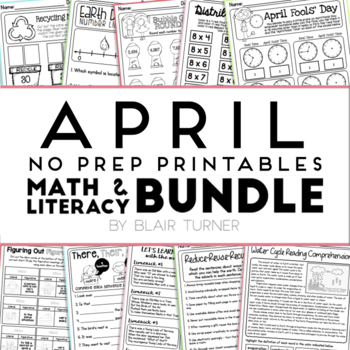April NO PREP Printables: Math and Literacy BUNDLE
What educators are saying
Products in this Bundle (2)
Also included in
- No Prep Math and LiteracyNever run out of printables again! This HUGE bundle of monthly no-prep printables for math and literacy is a go-to resource for the entire year. These fun pages can be used in so many ways - morning work, homework, independent practice, etc. - to help your students review esPrice $58.80Original Price $84.00Save $25.20
Description
These April no prep math and literacy printables are an easy way to review key skills throughout the month!
••••••••••••••••••••••••••••••••••••••••••••••••••••••••••••••••••••••••••••••••••••
April No Prep Literacy Printables
•Springtime Similes
•5W Poetry
•Similes and Metaphors
•Figuring Out Figurative Language
•Rain, Rain, Go Away! Persuasive Letter Writing Prompt
•Let's Learn About Limericks
•Water Cycle Reading Comprehension
•Reduce Reuse Recycle: Identifying Adverbs
•There, Their, or They're?
•Following Directions Quiz (Happy April Fools' Day!)
• Answer Keys included for all pages
• CCSS Alignment included on separate page for teacher reference
• Recycling Number Bonds
• Earth Day Fractions on a Number Line
• Bubble Gum Rounding
• April Fools' Day Elapsed Time
• Fraction Word Problems
• Order of Operations Equations
• April Showers Logic Problem
• Distributive Property Match-Up
• 100 Busy Bees (Addition and Subtraction Strategies)
• Answer Keys included for all pages
• CCSS Alignment included on separate page for teacher reference
• Answer Keys included for all pages
• CCSS Alignment included on separate page for teacher reference
••••••••••••••••••••••••••••••••••••••••••••••••••••••••••••••••••••••••••••••••••••
LOOKING FOR AN ENTIRE YEAR'S WORTH OF NO PREP PRINTABLES? Click here to see the year-long bundle!
••••••••••••••••••••••••••••••••••••••••••••••••••••••••••••••••••••••••••••••••••••
© Blair Turner, One Lesson at a Time, Inc.
Materials are licensed for personal use in one classroom only. For use in multiple classrooms, please purchase additional licenses.





